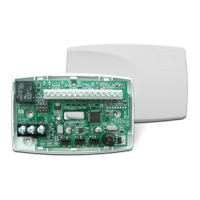LC (Remote LED Control)
Terminal 5 provides an unsupervised switched ground for a visual indicator that turns on when the Model 734 relay
activates. Connect the negative side of an LED controller to J3 terminal 5. The LED turns on for the duration the
door strike relay is on.
Note: HID readers optionally provide a connection for LED reader control.
RA (Remote Annunciation)
Terminal 6 provides an unsupervised switched ground for a remote annunciator (RA) that turns on when the Model
734 on-board piezo turns on. Connect the negative side of a remote annunciator to J3 terminal 6. The remote
annunciator activates when the RA switches to ground. The remote annunciator silences when the RA restores.
AS (Armed Status)
Terminal 7 provides an unsupervised switched ground for a visual or audible armed status indicator that turns on
when the area Armed Status is sent to the 734 such as SYSTEM ON or ALL SYSTEM ON. Connect the negative side
of an Armed Status output to J3 terminal 7. The AS terminal may stay grounded up to 20 seconds after the system
disarms.
Zone Terminals
Terminals 8 through 12 on J3 connect grounded zones 1 through 3. These zones have a grounded side and cannot
be used for re-initiating devices. Zones 2 and 3 can also be used for access control with Zone 2 providing a Soft-
Shunt™ feature and Zone 3 providing Request to Exit functionality. Zone 4 terminals provide a non-powered Class B
ungrounded zone suitable for connection to re devices such as 4-wire smoke or heat detectors. Refer to LT-0164
for a current list of 4-wire smoke detectors. Use the supplied, DMP Model 311 1K Ohm End-of-Line resistors on each
zone. Refer to the panel programming guide for programming instructions.
Note: A mechanical means of resetting four-wire smoke detectors or other latching devices on Zone 4 must be
provided. The panel does not drop power to the keypad bus when a Sensor Reset is performed.
NC/C/NO (Dry Contact Relay)
The 734 also provides an internal Form C (SPDT) relay for controlling door strikes or magnetic locks. The three relay
terminals on J1 marked NC C NO allow you to connect the device wiring to the relay for module control. See Figures
4 and 5 for proper door strike and magnetic lock wiring.
The Form C relay draws up to 35mA of current and its contacts are rated for 10 Amps at 12 VDC.
When connecting multiple locks to the Form C relay, the total current for all locks cannot exceed
10 Amps. If the total current for all locks exceeds 10 Amps, problems may arise and an isolation relay
may be needed.
KYPD IN (Keypad In)
Receives and transmits data to the panel Keypad bus.
KYPD OUT (Keypad Out)
Transmits keypad bus data out to other keypad(s) or modules. Install a dual connector four-position harness to allow
daisy chain connection to keypad(s) or other devices, up to the maximum number of devices supported by the bus.
PROG (Programming)
The 734 module is programmable from a 32-character keypad set to address one. Connect the keypad to the board
using a Model 330 4-wire harness. Programming starts as soon as the keypad is connected.
Status LEDs
The 734 board contains three status LEDs. The Red LED turns on for the duration that the door strike relay is
activated. The Yellow LED turns on for one second to indicate receipt of a Wiegand input. The Green LED indicates
data sent to the panel.
12 VDC Power
You can power the 734 module from a 12 VDC power source. The 12 VDC power can be provided by the panel or
from a separate listed burglary and re alarm auxiliary power supply. Do not ground the power supply to the 734 or
Command Processor™ panel. Power Supplies must have battery backup and be power limited.
Direct Voltage Output to Reader
The 734 provides direct 12 VDC output to the reader on the J3 Red terminal connection. The 734 contains an on-
board current limiting device that protects the 734 from shorts on the output voltage through external wiring.
734 Installation and Programming Guide Digital Monitoring Products
3

